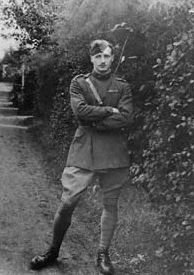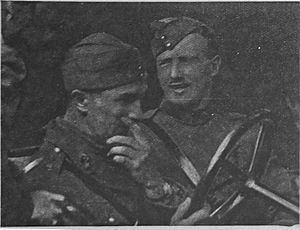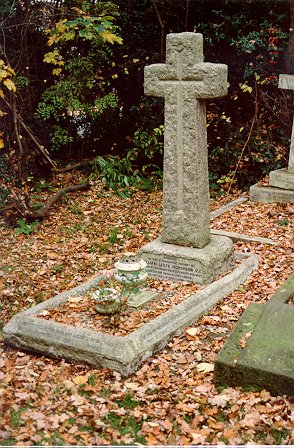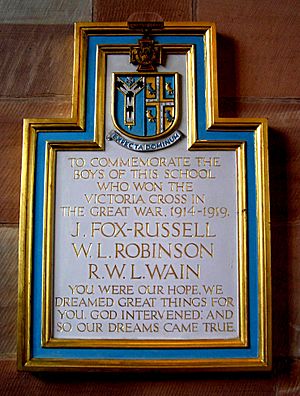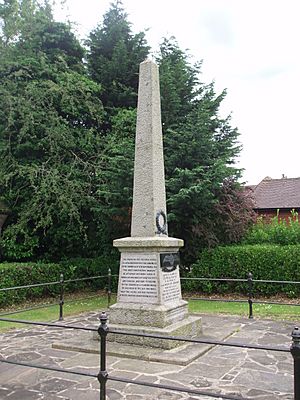Leefe Robinson facts for kids
Quick facts for kids
Leefe Robinson
|
|
|---|---|
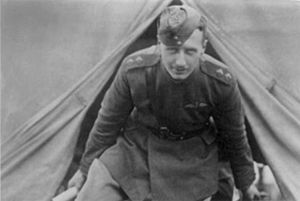 |
|
| Birth name | William Leefe Robinson |
| Born | 14 July 1895 Pollibetta, Coorg, India |
| Died | 31 December 1918 (aged 23) Stanmore, Middlesex, England |
| Buried |
All Saints' Churchyard Extension, Harrow Weald, Middlesex
|
| Allegiance | |
| Years of service | 1914–1918 |
| Rank | Captain |
| Unit | 39 Squadron 48 Squadron |
| Commands held | Flight Commander |
| Battles/wars | World War I |
| Awards | Victoria Cross |
William Leefe Robinson was a brave British pilot during World War I. He made history by being the first pilot to shoot down a German airship over Britain. For this amazing act, he received the Victoria Cross (VC). This is the highest award for bravery given to British and Commonwealth soldiers. He was also the first person to get the VC for an action that happened in the UK.
His success changed how the war was fought against German airships. It made the German bombing attacks less effective. In the three months after his famous flight, five more airships were shot down. This happened because other pilots used the same flying and fighting methods he had shown worked.
Contents
Early Life and School
William Leefe Robinson was born in Coorg, India, on July 14, 1895. He was the youngest son of Horace and Elizabeth Robinson. He grew up on his parents' coffee farm in Pollibetta.
He went to school at Bishop Cotton Boys' School in Bangalore, India. Later, he studied at the Dragon School in Oxford, England. In 1909, he joined his older brother Harold at St Bees School in Cumberland. He became the head of his school house in 1913. He also played for the school's rugby team and became a sergeant in the school's army training group.
Joining the First World War
In August 1914, William joined the Royal Military College, Sandhurst. This is a famous army training school. By December, he was officially part of the Worcestershire Regiment. In March 1915, he went to France as an observer for the Royal Flying Corps. This was the air force at the time.
After being hurt during a flight over Lille, he returned to Britain. He trained to become a pilot there. Then, he joined No. 39 (Home Defence) Squadron. This squadron flew at night from Sutton's Farm airfield in Essex. Their job was to protect Britain from enemy air attacks.
The Famous Victoria Cross Flight
On the night of September 2-3, 1916, Lieutenant Robinson was flying his plane. It was a special B.E.2c night fighter. He was flying over Cuffley, which was in Essex at the time. He spotted a German airship. This airship was one of 16 that had left Germany for a huge bombing raid over England. The airship he found was the Schütte-Lanz SL 11.
Robinson flew for several hours. He first saw the airship but then lost it in the clouds. Later, he found it again. He attacked it from below at a height of about 3,500 meters (11,500 feet). He got very close, within 150 meters (500 feet). He fired his machine gun at the airship using special incendiary bullets. These first two attacks didn't work.
He then used his third and last drum of ammunition. This time, the airship suddenly burst into flames! It crashed in a field behind a pub called the Plough Inn in Cuffley. The airship's commander, Wilhelm Schramm, and his 15 crew members all died.
After landing, Leefe Robinson wrote a report about his flight. He described how he found the airship and attacked it. He said he fired three times, and on the third try, the airship caught fire. He was very excited after his success.
This victory was incredibly important for the British government. It showed that they could fight back against the German airship attacks. It gave people hope and confidence.
Becoming a National Hero
Robinson landed his damaged plane at 2:45 a.m. His squadron cheered loudly for him. He woke up the next morning to find he was a national hero. His story was in all the major newspapers. People were very excited to meet him. Thousands of people went to Cuffley to see the remains of the crashed airship. Pieces of the airship were even sold to raise money for charity.
Just two days later, Robinson received the Victoria Cross. This was one of the fastest times anyone had ever received the medal. He got the medal on September 9 at Windsor Castle. Huge crowds came to see him. Robinson also received £3,500 in prize money and a silver cup.
However, on September 16, he crashed his plane while trying to take off for a night patrol. The plane was completely destroyed, but he managed to escape before it burned. After this, he was told not to fly combat missions anymore. He was too important as a national hero and had many official events to attend. Only the propeller of his plane survived. It is now on display at Culzean Castle in Scotland.
Leefe Robinson's success proved that using concentrated upward fire with incendiary bullets worked. Other pilots quickly used his methods. On September 23, 1916, Frederick Sowrey from the same squadron shot down another Zeppelin, the L.32. A week later, on October 1, 1916, Wulstan Tempest also from 39 Squadron, shot down the Zeppelin L.31. In total, five more German airships were destroyed by British planes between October and December 1916.
Fighting on the Western Front
William Leefe Robinson kept asking to return to active flying. In April 1917, he was sent to France. He became a flight commander with No. 48 Squadron. He flew the new Bristol F.2 Fighter plane.
On his very first patrol over the enemy lines, on April 5, Robinson's group of six planes met German Albatros D.III fighters. These were led by the famous pilot Manfred von Richthofen, also known as the Red Baron. Four of Robinson's planes were shot down. Robinson's plane was shot down by a German pilot named Sebastian Festner. Robinson was wounded and captured.
For two months, he was thought to be dead. Then, a letter arrived from him from a POW camp. While he was a prisoner, he tried to escape several times. Because of his escape attempts, he was moved to different camps. He was even kept alone in a special cell at the Holzminden camp. It is believed that being a prisoner badly affected his health.
His Final Days
William Leefe Robinson was sent home in early December 1918. He was able to spend Christmas with his family and friends. But his freedom did not last long. He caught the Spanish flu, a very serious illness at the time. He died on December 31, 1918, at his sister's home in Stanmore. Many believed his time as a prisoner made him more likely to get sick.
He was buried with a big ceremony at All Saints' Churchyard Extension in Harrow Weald. Thousands of people came to watch the procession. The Royal Air Force band led the way. Airplanes flew overhead and dropped a wreath onto his grave.
Remembering a Hero
A special memorial was built for Robinson in Cuffley. It is close to where the airship crashed. The land for the memorial was given by Mrs. J. M. B. Kidson. The money for the monument came from readers of the Daily Express newspaper. It is a tall stone pillar, about 5.1 meters (16.7 feet) high. It has Royal Flying Corps "wings" carved on it. It also has an inscription that says:
To the memory of Captain William Leefe Robinson VC, Worcs. Regt and R.F.C. who on 3 September 1916 above this spot brought down SL11, the first German airship destroyed on British soil.
The monument was revealed to a large crowd on June 9, 1921. The inscription first said the airship was Z21, but this was corrected in 1966. The memorial was fixed up and rededicated in 1986. It was repaired again between 2007 and 2008 because it was sinking on one side. A special service was held on December 31, 2018, to mark 100 years since his death. An exhibition of photos and items about Robinson was also shown.
A road in Hornchurch, Essex, is named after him (Robinson Close). It is on the site of the old Suttons Farm airfield. You can see Robinson in a short old newsreel video from wartime. His name is also on a special memorial at St Bees School chapel, which honors three Victoria Cross winners. His name is also on a memorial at the Madikeri (Coorg) museum in India.
A local restaurant in Harrow Weald is named after him, the Leefe Robinson VC. It was first opened in 1954 and had items from his life. Sadly, these were destroyed in a fire in the 1960s.
In April 2010, a train was named Captain William Leefe Robinson VC. This was to celebrate 100 years of a railway line that connects Grange Park to Cuffley.
See also
- Reginald Warneford – another VC winner who shot down a Zeppelin.


